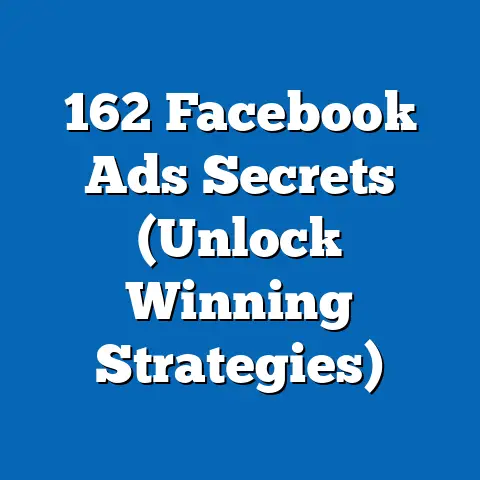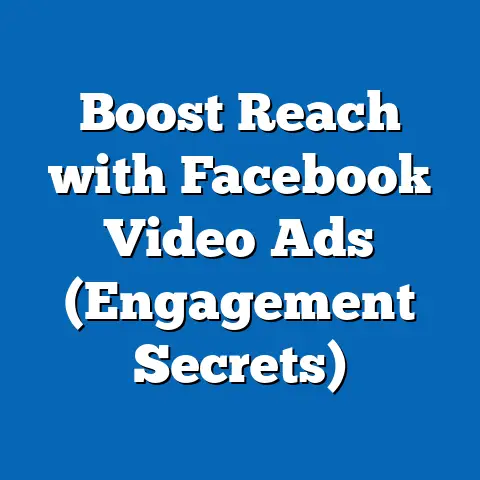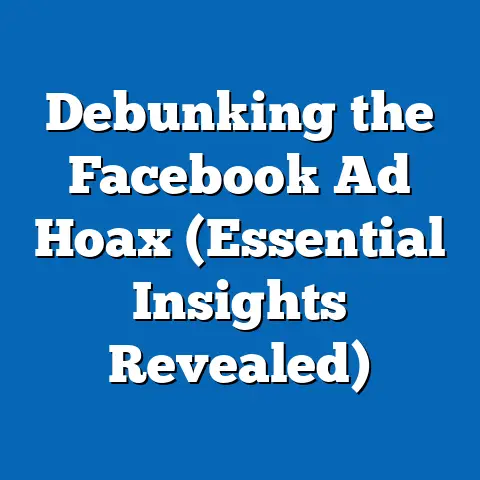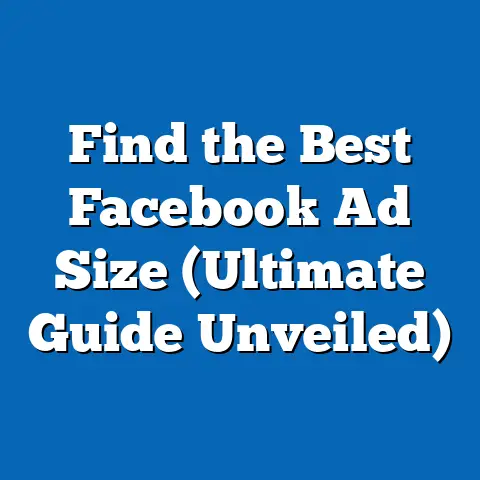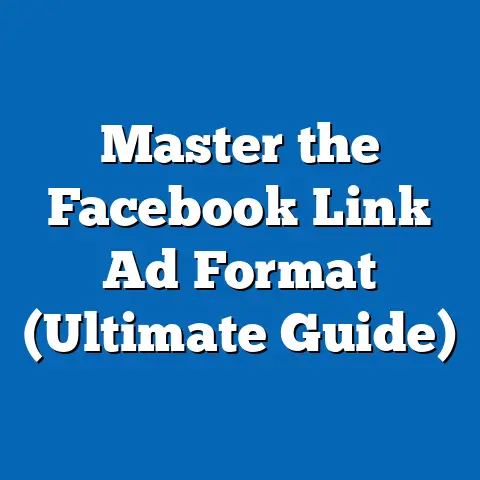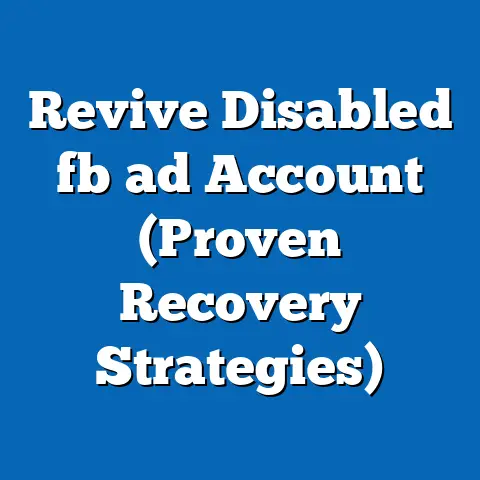Boost Facebook Ads: Maximize Impact (Strategic Insights)
I’ve been working with Facebook Ads for over a decade, and something I’ve noticed time and again is that the best campaigns aren’t just about immediate sales. They’re about building a brand, fostering loyalty, and ultimately, increasing the long-term value of your business. Think of it like this: effective advertising is an investment, not just an expense. It’s like renovating a house – you might spend money upfront, but you’re increasing its resale value down the line.
Introduction: The Resale Value of Effective Advertising
In the bustling digital marketplace, where businesses vie for attention and customers navigate a sea of choices, the concept of resale value is often overlooked in advertising strategies. Yet, the true measure of effective advertising lies not just in immediate revenue generation but in its ability to build a brand that resonates, fosters customer loyalty, and ultimately enhances a company’s long-term marketability and resale value.
Think of a brand like Apple. Their advertising doesn’t just sell products; it sells a lifestyle, an experience, and a sense of belonging. This has created incredible brand loyalty and a premium perception, making Apple one of the most valuable companies in the world. This wasn’t built overnight; it was the result of consistent, effective advertising that built a strong brand identity.
Conversely, I’ve seen businesses that treat Facebook Ads as a quick fix. They focus solely on short-term gains, neglecting the crucial aspects of brand building and customer engagement. When these companies eventually look to sell or seek investment, they often find their brand lacks the equity and loyalty that would significantly increase their valuation.
It’s crucial to understand that Facebook ads, when strategically crafted and executed, are an investment in future returns. It’s about building a valuable asset – a brand that customers trust, recognize, and are willing to choose over competitors.
Throughout this guide, I’ll show you how to structure your Facebook advertising efforts to achieve both immediate and long-term success, ultimately boosting your brand’s “resale value.”
Section 1: Understanding the Facebook Advertising Ecosystem
Before diving into the strategic aspects, it’s essential to have a solid understanding of the Facebook advertising ecosystem. This includes grasping the platform’s reach, its relevance to different industries, and the functionalities of the Facebook Ads Manager.
1.1 The Importance of Facebook in Digital Marketing
Facebook, despite the rise of newer platforms, remains a digital marketing powerhouse. Here’s why:
-
Massive User Base: Facebook boasts billions of active users worldwide, providing an unparalleled reach for advertisers. As of early 2024, Facebook has nearly 3 billion daily active users. This sheer volume means you have a high chance of reaching your target audience, no matter how niche.
-
Detailed Demographics & Interests: Facebook’s data collection is incredibly sophisticated. Users willingly share their interests, demographics, and behaviors, allowing advertisers to target with laser precision. I’ve run campaigns targeting specific professions within a certain radius of a city and have been blown away by the accuracy.
-
Diverse Ad Formats: From image ads and video ads to carousel ads and collection ads, Facebook offers a wide range of formats to suit different marketing objectives. I’ve found that experimenting with different ad formats is crucial for finding what resonates best with your audience.
-
Engagement Opportunities: Facebook is inherently social. Ads can generate likes, comments, shares, and direct messages, fostering engagement and building a community around your brand.
-
Relevance Across Industries: While some platforms are better suited for specific industries (e.g., LinkedIn for B2B), Facebook’s broad appeal makes it relevant for almost any business. Whether you’re selling e-commerce products, promoting a local restaurant, or offering professional services, Facebook can be a valuable tool.
Massive User Base: Facebook boasts billions of active users worldwide, providing an unparalleled reach for advertisers. As of early 2024, Facebook has nearly 3 billion daily active users. This sheer volume means you have a high chance of reaching your target audience, no matter how niche.
Detailed Demographics & Interests: Facebook’s data collection is incredibly sophisticated. Users willingly share their interests, demographics, and behaviors, allowing advertisers to target with laser precision. I’ve run campaigns targeting specific professions within a certain radius of a city and have been blown away by the accuracy.
Diverse Ad Formats: From image ads and video ads to carousel ads and collection ads, Facebook offers a wide range of formats to suit different marketing objectives. I’ve found that experimenting with different ad formats is crucial for finding what resonates best with your audience.
Engagement Opportunities: Facebook is inherently social. Ads can generate likes, comments, shares, and direct messages, fostering engagement and building a community around your brand.
Relevance Across Industries: While some platforms are better suited for specific industries (e.g., LinkedIn for B2B), Facebook’s broad appeal makes it relevant for almost any business. Whether you’re selling e-commerce products, promoting a local restaurant, or offering professional services, Facebook can be a valuable tool.
Key Takeaway: Facebook’s massive reach, detailed targeting, and diverse ad formats make it a crucial platform for digital marketing, regardless of your industry.
1.2 The Facebook Ads Manager: An Overview
The Facebook Ads Manager is your central hub for creating, managing, and analyzing your Facebook advertising campaigns. Understanding its structure is paramount.
-
Campaigns: At the highest level, a campaign defines your overall advertising objective. Are you aiming for brand awareness, lead generation, or conversions? Choosing the right campaign objective is crucial, as it influences how Facebook optimizes your ads. I always recommend starting with a clear objective in mind before even touching the Ads Manager.
-
Ad Sets: Within each campaign, you have ad sets. Ad sets define your target audience, budget, placement (where your ads will appear), and schedule. This is where you fine-tune your targeting parameters, ensuring your ads reach the right people at the right time. I’ve found that creating multiple ad sets with slightly different targeting parameters within a single campaign can be a powerful way to test and optimize your audience reach.
-
Ads: At the lowest level are your individual ads. These consist of your creative elements – images, videos, copy, and call-to-action buttons. This is where you grab the user’s attention and persuade them to take action. I can’t stress enough the importance of compelling ad creative. A poorly designed ad, even with perfect targeting, will likely fail.
Campaigns: At the highest level, a campaign defines your overall advertising objective. Are you aiming for brand awareness, lead generation, or conversions? Choosing the right campaign objective is crucial, as it influences how Facebook optimizes your ads. I always recommend starting with a clear objective in mind before even touching the Ads Manager.
Ad Sets: Within each campaign, you have ad sets. Ad sets define your target audience, budget, placement (where your ads will appear), and schedule. This is where you fine-tune your targeting parameters, ensuring your ads reach the right people at the right time. I’ve found that creating multiple ad sets with slightly different targeting parameters within a single campaign can be a powerful way to test and optimize your audience reach.
Ads: At the lowest level are your individual ads. These consist of your creative elements – images, videos, copy, and call-to-action buttons. This is where you grab the user’s attention and persuade them to take action. I can’t stress enough the importance of compelling ad creative. A poorly designed ad, even with perfect targeting, will likely fail.
Significance of Each Component:
- Campaigns: Provide the strategic direction for your advertising efforts.
- Ad Sets: Enable precise targeting and budget allocation.
- Ads: Deliver your message and drive action.
Key Takeaway: The Facebook Ads Manager is structured hierarchically: Campaigns > Ad Sets > Ads. Understanding this structure is essential for creating effective and well-organized advertising campaigns.
Section 2: Crafting a High-Impact Facebook Ad Strategy
Now that you have a grasp of the Facebook advertising ecosystem, let’s move on to crafting a high-impact ad strategy. This involves defining your objectives, understanding your audience, creating compelling ad creative, and using A/B testing to optimize performance.
2.1 Defining Your Objectives
Before launching any Facebook ad campaign, it’s crucial to define your objectives. What do you want to achieve with your advertising efforts? Common objectives include:
- Brand Awareness: Increasing recognition and familiarity with your brand.
- Lead Generation: Collecting contact information from potential customers.
- Conversions: Driving sales, sign-ups, or other desired actions on your website.
- Website Traffic: Driving more visitors to your website.
- Engagement: Increasing likes, comments, shares on your Facebook page.
- App Installs: Driving downloads of your mobile app.
Aligning Advertising Goals with Business Objectives:
Your advertising goals should align with your overall business objectives. For example, if your business objective is to increase sales by 20% in the next quarter, your Facebook advertising goals should focus on driving conversions. If you’re launching a new product, brand awareness might be your initial focus.
I’ve seen businesses waste money on advertising campaigns that don’t align with their overall goals. For example, running a lead generation campaign when your website isn’t optimized for conversions is like pouring water into a leaky bucket.
Key Takeaway: Define clear, measurable advertising objectives that align with your overall business goals.
2.2 Target Audience Segmentation
Understanding your audience is paramount to successful Facebook advertising. Facebook offers a wide range of targeting options that allow you to create specific segments based on:
- Demographics: Age, gender, location, education, job title, etc.
- Interests: Hobbies, passions, topics they follow on Facebook.
- Behaviors: Purchase history, online activity, device usage.
- Connections: People who like your page, friends of people who like your page.
- Custom Audiences: Uploading your own customer data (e.g., email lists) to target existing customers or create lookalike audiences.
- Lookalike Audiences: Facebook identifies users who share similar characteristics with your existing customers.
Using Facebook’s Audience Targeting Tools:
-
Detailed Targeting: Use the detailed targeting options to narrow down your audience based on interests, behaviors, and demographics. I recommend starting broad and then refining your targeting based on performance data.
-
Custom Audiences: Upload your customer email list to target existing customers with special offers or loyalty programs. This is one of the most effective ways to drive repeat business.
-
Lookalike Audiences: Create lookalike audiences based on your existing customers to reach new potential customers who share similar characteristics. I’ve found that lookalike audiences often outperform traditional targeting methods.
Detailed Targeting: Use the detailed targeting options to narrow down your audience based on interests, behaviors, and demographics. I recommend starting broad and then refining your targeting based on performance data.
Custom Audiences: Upload your customer email list to target existing customers with special offers or loyalty programs. This is one of the most effective ways to drive repeat business.
Lookalike Audiences: Create lookalike audiences based on your existing customers to reach new potential customers who share similar characteristics. I’ve found that lookalike audiences often outperform traditional targeting methods.
Key Takeaway: Understanding your audience and using Facebook’s targeting tools to create specific segments is crucial for maximizing the impact of your ads.
2.3 Compelling Ad Creative
Your ad creative is what grabs the user’s attention and persuades them to take action. Key elements of effective ad creative include:
- Visuals: High-quality images or videos that are relevant to your target audience and offer.
- Copy: Clear, concise, and persuasive text that highlights the benefits of your offer.
- Call-to-Action (CTA): A clear and compelling CTA button that tells the user what you want them to do (e.g., “Shop Now,” “Learn More,” “Sign Up”).
Examples of Successful Ad Creatives:
- Dollar Shave Club: Their humorous and relatable video ads went viral, driving massive brand awareness and sales.
- Airbnb: Their high-quality photos of unique accommodations inspire wanderlust and drive bookings.
- Nike: Their inspirational and empowering ads resonate with athletes and fitness enthusiasts.
Analyzing What Makes Them Effective:
- Relevance: The ads are highly relevant to the target audience’s interests and needs.
- Value Proposition: The ads clearly communicate the benefits of the offer.
- Emotional Connection: The ads evoke emotions that resonate with the target audience.
- Clear CTA: The ads have a clear and compelling call-to-action.
Key Takeaway: Compelling ad creative is essential for grabbing attention, communicating your value proposition, and driving action.
2.4 A/B Testing for Optimization
A/B testing (also known as split testing) is the process of comparing two versions of an ad to see which one performs better. This is a crucial step in refining your ad performance and maximizing your ROI.
Step-by-Step Guide to Conducting A/B Tests:
- Identify What to Test: Choose one element of your ad to test at a time (e.g., headline, image, CTA).
- Create Two Versions: Create two versions of your ad with only the element you’re testing being different.
- Run the Test: Set up your A/B test in Facebook Ads Manager and let it run for a sufficient period of time (usually at least a week) to gather enough data.
- Analyze the Results: After the test is complete, analyze the results to see which version performed better.
- Implement the Winner: Implement the winning version of your ad in your ongoing campaigns.
- Repeat the Process: Continuously A/B test different elements of your ads to keep improving performance.
Key Takeaway: A/B testing is a crucial step in refining your ad performance and maximizing your ROI. Continuously test different elements of your ads to identify what resonates best with your audience.
Section 3: Budgeting and Bidding Strategies
Now that you have a solid understanding of ad strategy, let’s dive into the financial aspects of Facebook advertising: budgeting and bidding.
3.1 Setting Your Budget
Setting the right budget is crucial for achieving your advertising goals without overspending.
-
Daily vs. Lifetime Budgets:
- Daily Budget: Sets an average amount you’re willing to spend each day. This is ideal for campaigns that run continuously.
- Lifetime Budget: Sets a total amount you’re willing to spend over the entire duration of the campaign. This is ideal for campaigns with a specific start and end date.
-
How to Choose the Right Budget:
- Start with a Test Budget: Before committing to a large budget, start with a small test budget to see how your ads perform.
- Consider Your Goals: Your budget should be aligned with your advertising goals. If you’re aiming for brand awareness, you may need a larger budget to reach a wider audience. If you’re aiming for conversions, you can start with a smaller budget and scale up as you see results.
- Monitor Your ROI: Continuously monitor your ROI (Return on Investment) to ensure you’re getting a good return on your ad spend.
Daily vs. Lifetime Budgets:
- Daily Budget: Sets an average amount you’re willing to spend each day. This is ideal for campaigns that run continuously.
- Lifetime Budget: Sets a total amount you’re willing to spend over the entire duration of the campaign. This is ideal for campaigns with a specific start and end date.
How to Choose the Right Budget:
- Start with a Test Budget: Before committing to a large budget, start with a small test budget to see how your ads perform.
- Consider Your Goals: Your budget should be aligned with your advertising goals. If you’re aiming for brand awareness, you may need a larger budget to reach a wider audience. If you’re aiming for conversions, you can start with a smaller budget and scale up as you see results.
- Monitor Your ROI: Continuously monitor your ROI (Return on Investment) to ensure you’re getting a good return on your ad spend.
Key Takeaway: Choose the right budgeting strategy (daily vs. lifetime) and set a budget that aligns with your advertising goals. Continuously monitor your ROI to ensure you’re getting a good return on your ad spend.
3.2 Bidding Options and Strategies
Facebook offers several bidding options, each with its own pros and cons.
- Cost-Per-Click (CPC): You pay each time someone clicks on your ad. This is ideal for driving traffic to your website.
- Cost-Per-Impression (CPM): You pay for every 1,000 impressions of your ad. This is ideal for brand awareness campaigns.
- Cost-Per-Action (CPA): You pay only when someone takes a specific action, such as making a purchase or signing up for a newsletter. This is ideal for conversion-focused campaigns.
Selecting the Appropriate Bidding Strategy:
- CPC: Use CPC bidding if your primary goal is to drive traffic to your website and you’re confident that your landing page will convert visitors into customers.
- CPM: Use CPM bidding if your primary goal is to increase brand awareness and reach a large audience.
- CPA: Use CPA bidding if your primary goal is to drive conversions and you have a well-optimized website or landing page.
Key Takeaway: Choose the bidding strategy that aligns with your campaign objectives. If you want traffic, use CPC; for awareness, use CPM; and for conversions, use CPA.
Section 4: Measuring Success and Analytics
Measuring the success of your Facebook ad campaigns is crucial for understanding what’s working and what’s not.
4.1 Key Performance Indicators (KPIs)
Key Performance Indicators (KPIs) are metrics that help you gauge the performance of your campaigns. Essential KPIs for Facebook ad success include:
- Click-Through Rate (CTR): The percentage of people who see your ad and click on it. A high CTR indicates that your ad is relevant and engaging.
- Cost-Per-Click (CPC): The amount you pay for each click on your ad. A low CPC indicates that your ad is cost-effective.
- Conversion Rate: The percentage of people who click on your ad and then take a desired action, such as making a purchase or signing up for a newsletter. A high conversion rate indicates that your landing page is effective.
- Return on Ad Spend (ROAS): The amount of revenue you generate for every dollar you spend on advertising. A high ROAS indicates that your campaigns are profitable.
- Cost Per Acquisition (CPA): The cost of acquiring a new customer through your advertising efforts. A low CPA indicates that your campaigns are efficient.
Interpreting These Metrics:
- High CTR, Low Conversion Rate: Your ad is engaging, but your landing page needs improvement.
- Low CTR, High Conversion Rate: Your ad isn’t very engaging, but your landing page is highly effective.
- High CPC, Low Conversion Rate: Your ad is expensive, and your landing page needs improvement.
- Low CPC, High Conversion Rate: Your ad is cost-effective, and your landing page is effective.
Key Takeaway: Track essential KPIs like CTR, CPC, conversion rate, ROAS, and CPA to gauge the performance of your campaigns and identify areas for improvement.
4.2 Using Facebook Insights and Analytics
Facebook Insights provides a wealth of data about your audience, your ads, and your page performance.
- Audience Insights: Understand the demographics, interests, and behaviors of your audience.
- Ad Performance: Track the performance of your ads, including impressions, clicks, conversions, and cost.
- Page Performance: See how your page is performing, including likes, shares, comments, and reach.
Leveraging Data for Strategic Decisions:
- Refine Targeting: Use audience insights to refine your targeting parameters and reach a more relevant audience.
- Optimize Ad Creative: Use ad performance data to optimize your ad creative and improve your CTR and conversion rate.
- Improve Landing Page: Use conversion rate data to identify areas for improvement on your landing page.
- Adjust Budget: Use ROAS data to adjust your budget and allocate more resources to your most profitable campaigns.
Key Takeaway: Use Facebook Insights and Analytics to gather data about your audience, your ads, and your page performance. Leverage this data to refine your targeting, optimize your ad creative, improve your landing page, and adjust your budget.
Section 5: Advanced Techniques for Maximizing Impact
Now that you have a solid foundation in Facebook advertising, let’s explore some advanced techniques for maximizing impact.
5.1 Retargeting and Remarketing Strategies
Retargeting (also known as remarketing) is the process of showing ads to people who have previously interacted with your website or Facebook page. This is a highly effective way to drive conversions and increase brand awareness.
- Website Retargeting: Show ads to people who have visited your website but haven’t made a purchase or signed up for a newsletter.
- Facebook Page Retargeting: Show ads to people who have liked your Facebook page or interacted with your posts.
- Video Retargeting: Show ads to people who have watched a certain percentage of your video ads.
Case Studies of Successful Retargeting Efforts:
- E-commerce Store: Retargeting website visitors who abandoned their shopping carts with a special discount code.
- Software Company: Retargeting website visitors who downloaded a free trial with a personalized demo invitation.
- Local Restaurant: Retargeting Facebook page fans with a special offer for their next visit.
Key Takeaway: Retargeting is a highly effective way to drive conversions and increase brand awareness. Show ads to people who have previously interacted with your website or Facebook page.
5.2 Leveraging User-Generated Content (UGC)
User-Generated Content (UGC) is content created by your customers or fans, such as reviews, testimonials, photos, and videos. UGC can be a powerful tool for enhancing ad credibility and engagement.
-
Benefits of UGC:
- Increased Credibility: UGC is seen as more credible than branded content.
- Higher Engagement: UGC is more likely to be shared and commented on.
- Lower Costs: UGC can be less expensive to create than branded content.
-
Tips on How to Encourage and Incorporate UGC:
- Run Contests: Encourage customers to submit photos or videos of themselves using your products.
- Ask for Reviews: Ask customers to leave reviews on your Facebook page or website.
- Share Customer Photos: Share customer photos on your Facebook page and in your ads.
- Feature Testimonials: Feature customer testimonials in your ads.
Benefits of UGC:
- Increased Credibility: UGC is seen as more credible than branded content.
- Higher Engagement: UGC is more likely to be shared and commented on.
- Lower Costs: UGC can be less expensive to create than branded content.
Tips on How to Encourage and Incorporate UGC:
- Run Contests: Encourage customers to submit photos or videos of themselves using your products.
- Ask for Reviews: Ask customers to leave reviews on your Facebook page or website.
- Share Customer Photos: Share customer photos on your Facebook page and in your ads.
- Feature Testimonials: Feature customer testimonials in your ads.
Key Takeaway: Leverage User-Generated Content (UGC) to enhance ad credibility and engagement. Encourage customers to create content about your brand and incorporate it into your ads.
5.3 Integrating Facebook Ads with Other Marketing Channels
Facebook ads should be part of a cohesive marketing strategy that includes other digital channels, such as email marketing, SEO, and content marketing.
-
Benefits of Cross-Channel Promotion:
- Increased Brand Visibility: Reaching customers on multiple channels increases brand visibility.
- Improved Customer Experience: Providing a consistent message across all channels improves the customer experience.
- Higher ROI: Integrating your marketing channels can lead to a higher ROI.
-
Examples of Cross-Channel Promotion:
- Promote Facebook Ads in Email Newsletters: Include links to your Facebook ads in your email newsletters.
- Promote Facebook Page on Your Website: Include a Facebook page badge on your website.
- Use Facebook Ads to Drive Traffic to Your Blog: Promote your blog posts with Facebook ads.
- Use SEO to Drive Traffic to Your Facebook Page: Optimize your Facebook page for search engines.
Benefits of Cross-Channel Promotion:
- Increased Brand Visibility: Reaching customers on multiple channels increases brand visibility.
- Improved Customer Experience: Providing a consistent message across all channels improves the customer experience.
- Higher ROI: Integrating your marketing channels can lead to a higher ROI.
Examples of Cross-Channel Promotion:
- Promote Facebook Ads in Email Newsletters: Include links to your Facebook ads in your email newsletters.
- Promote Facebook Page on Your Website: Include a Facebook page badge on your website.
- Use Facebook Ads to Drive Traffic to Your Blog: Promote your blog posts with Facebook ads.
- Use SEO to Drive Traffic to Your Facebook Page: Optimize your Facebook page for search engines.
Key Takeaway: Integrate Facebook ads with other marketing channels to increase brand visibility, improve the customer experience, and achieve a higher ROI.
Conclusion: The Long-Term Value of Facebook Advertising
In conclusion, Facebook advertising is not just about generating immediate sales; it’s about building a brand that resonates, fosters customer loyalty, and ultimately enhances your business’s long-term value. By defining clear objectives, understanding your audience, creating compelling ad creative, and using A/B testing to optimize performance, you can maximize the impact of your Facebook ads and drive sustainable growth.
Remember, the digital marketing landscape is constantly evolving. Stay up-to-date with the latest trends and changes in the Facebook advertising landscape to stay ahead of the competition. By continually refining your strategies and adapting to new technologies, you can ensure that your Facebook advertising efforts continue to drive results for years to come.
Call to Action:
I encourage you to implement the strategies discussed in this article and share your experiences in leveraging Facebook ads for business growth. Let’s build brands that not only generate revenue but also create lasting value! I’d love to hear about your successes (and challenges!) in the comments below. What are your biggest takeaways from this guide? What strategies are you most excited to implement? Let’s start a conversation and learn from each other!

